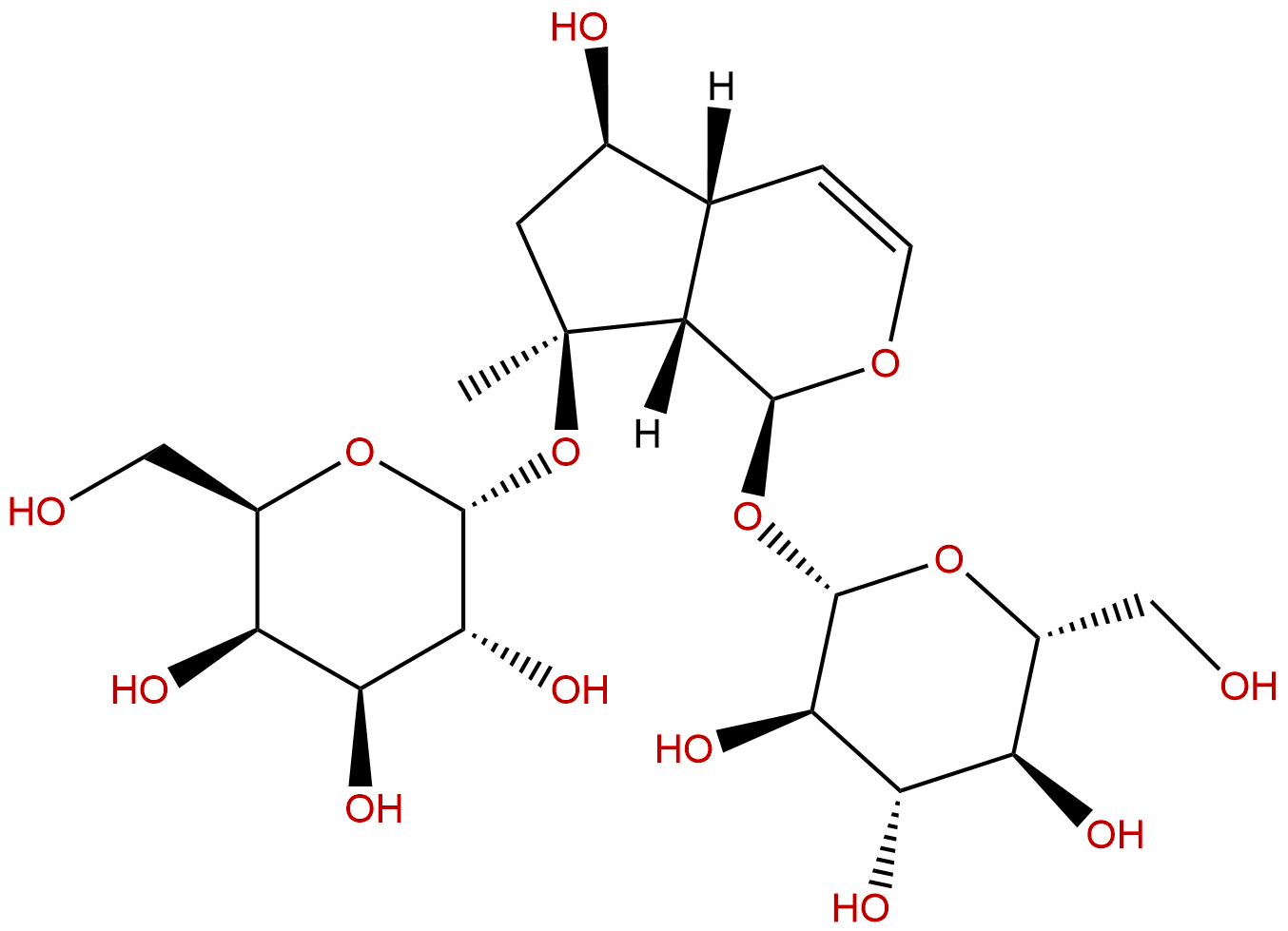
Rhmannioside CCAS No.:81720-07-2
|
||||||||||
 |
|
|
||||||||

| Catalogue No.: | BP3674 |
| Formula: | C21H34O14 |
| Mol Weight: | 510.489 |
Synonym name:
Catalogue No.: BP3674
Cas No.: 81720-07-2
Formula: C21H34O14
Mol Weight: 510.489
Botanical Source:
Purity: 95%~99%
Analysis Method: HPLC-DAD or/and HPLC-ELSD
Identification Method: Mass, NMR
Packing: Brown vial or HDPE plastic bottle
Can be supplied from milligrams to grams. Inquire for bulk scale.
For Reference Standard and R&D, Not for Human Use Directly.
Description:
Cornuside has immunomodulatory, and anti-inflammatory activities, it has protective potential against cerebral ischemic injury, may be due to the suppression of intracellular Ca(2+) elevation and caspase-3 activity, and improvements in mitochondrial energy metabolism and antioxidant properties. Cornuside can treat myocardial I/R and protect the liver from CCl₄-induced acute hepatotoxicity, by reducing oxidative stress and suppressing inflammatory responses.
References:
Biol Pharm Bull. 2007 Sep;30(9):1796-9.
Cornuside suppresses cytokine-induced proinflammatory and adhesion molecules in the human umbilical vein endothelial cells.
Cornuside is a bisiridoid glucoside compound isolated from the fruit of Cornus officinalis SIEB. et ZUCC.
METHODS AND RESULTS:
The present study was designed to examine the effects of Cornuside on expression levels of cytokine-induced proinflammatory and adhesion molecules in the human umbilical vein endothelial cells (HUVECs). Cornuside treatment attenuated tumor necrosis factor-alpha (TNF-alpha)-induced nuclear factor-kappa B (NF-kappaB) p65 translocation in HUVECs. In addition, Cornusidesuppressed the expression levels of endothelial cell adhesion molecules including intercellular adhesion molecule-1 (ICAM-1) and vascular cell adhesion molecule-1 (VCAM-1) induced by TNF-alpha. TNF-alpha-induced monocyte chemoattractant protein 1 (MCP-1) expression was also attenuated by treatment of Cornuside. These inhibitory effects of Cornuside on proinflammatory and adhesion molecules were not due to decreased HUVEC viability as assessed by MTT test.
CONCLUSIONS:
Taken together, the present study suggests that Cornuside suppresses expression levels of cytokine-induced proinflammatory and adhesion molecules in the human endothelial cells.
The FASEB Journal, 2006, 20(4):A668.
Cornuside exhibits vasodilatory and anti-inflammatory effects via a nitric oxide-cGMP pathway.
Vasorelaxant and anti-inflammatory effects of a Cornuside isolated from the fruits of Cornus officinalis and possible mechanisms responsible for this effect were investigated.
METHODS AND RESULTS:
Cornuside induced a concentration-dependent relaxation of the phenylephrine-precontracted rat aorta. This effect disappeared with the removal of functional endothelium. Pretreatment of the aortic tissues with either NG-nitro-L-arginine methyl ester (L-NAME) or 1H-[1,2,4]-oxadiazole-[4,3-α]-quinoxalin-1-one (ODQ) inhibited the relaxation induced by Cornuside. Incubation of carotid arteries isolated from rats with Cornuside increased the production of cGMP in a dose-dependent manner, but this effect was blocked by pretreatment with L-NAME and ODQ, respectively. Cornusidesuppressed the expression levels of adhesion molecules including intracellular cell adhesion molecule-1 (ICAM-1) and vascular cell adhesion molecule-1 (VCAM-1) induced by TNF-α in HUVECs. TNF-α-induced monocyte chemoattractant protein-1 (MCP-1) expression was also attenuated by treatment of Cornuside.
CONCLUSIONS:
Taken together, the present study suggests that Cornuside dilates vascular smooth muscle and suppresses the vascular inflammatory process via endothelium-dependent nitric oxide (NO)/cGMP signaling.
Phytomedicine. 2011 Feb 15;18(4):266-71.
Protective roles of cornuside in acute myocardial ischemia and reperfusion injury in rats.
Cornuside is a secoiridoid glucoside isolated from the fruit of Cornus officinalis SIEB. et ZUCC. In this study, we investigated the anti-myocardial ischemia and reperfusion (I/R) injury effects of Cornuside in vivo and elucidated the potential mechanism.
METHODS AND RESULTS:
Rat models of myocardial I/R were induced by coronary occlusion followed by reperfusion or by Isoproterenol (ISO), treatment of rats with Cornuside (20 and 40 mg/kg, i.v.) protected the animals from myocardial I/R injury as indicated by a decrease in infarct volume, improvement in hemodynamics and reduction of myocardial damage severity. Treatment with Cornuside also attenuated polymorphonuclear leukocytes (PMNs) infiltration, decreased myeloperoxidase (MPO) activity in the heart, lowered serum levels of pro-inflammatory factors and reduced phosphorylated IκB-α and nuclear factor kappa B (NF-κB) levels in the heart. Additionally, Cornuside was shown to have remarkable antioxidant activity and inhibited ISO-induced myocardial cell necrosis.
CONCLUSIONS:
Thus, Cornuside appeared to protect the rat from myocardial I/R injury by acting as an anti-inflammatory agent. These findings suggested that Cornuside may be used therapeutically in the setting of myocardial I/R where inflammation and oxidant injury are prominent.
Biosci Biotechnol Biochem. 2011;75(4):656-61.
Protective effect of cornuside against carbon tetrachloride-induced acute hepatic injury.
This study elucidated the effects of Cornuside on carbon tetrachloride (CCl₄)-induced hepatotoxicity.
METHODS AND RESULTS:
Rats were treated intraperitoneally with 0.5 mL/kg of CCl₄. Sixteen h after CCl₄ treatment, the levels of serum aminotransferases, tumor necrosis factor-α (TNF-α), and lipid peroxidation were significantly elevated, whereas the hepatic antioxidative enzyme activities were decreased. These changes were attenuated by Cornuside. Histological studies also indicated that Cornusideinhibited CCl₄-induced liver damage. Furthermore, the contents of hepatic nitrite, inducible nitric oxide synthase (iNOS), and cyclooxygenase-2 (COX-2) were elevated after CCl₄ treatment, while cytochrome P450 2E1 (CYP2E1) expression was suppressed. Cornuside treatment inhibited the formation of liver nitrite, and reduced the overexpression of iNOS and COX-2 proteins, but restored the liver CYP2E1 content as compared with the CCl₄-treated rats.
CONCLUSIONS:
Our data indicate that Cornuside protects the liver from CCl₄-induced acute hepatotoxicity, perhaps due to its ability to restore the CYP2E1 function and suppress inflammatory responses, in combination with its capacity to reduce oxidative stress.